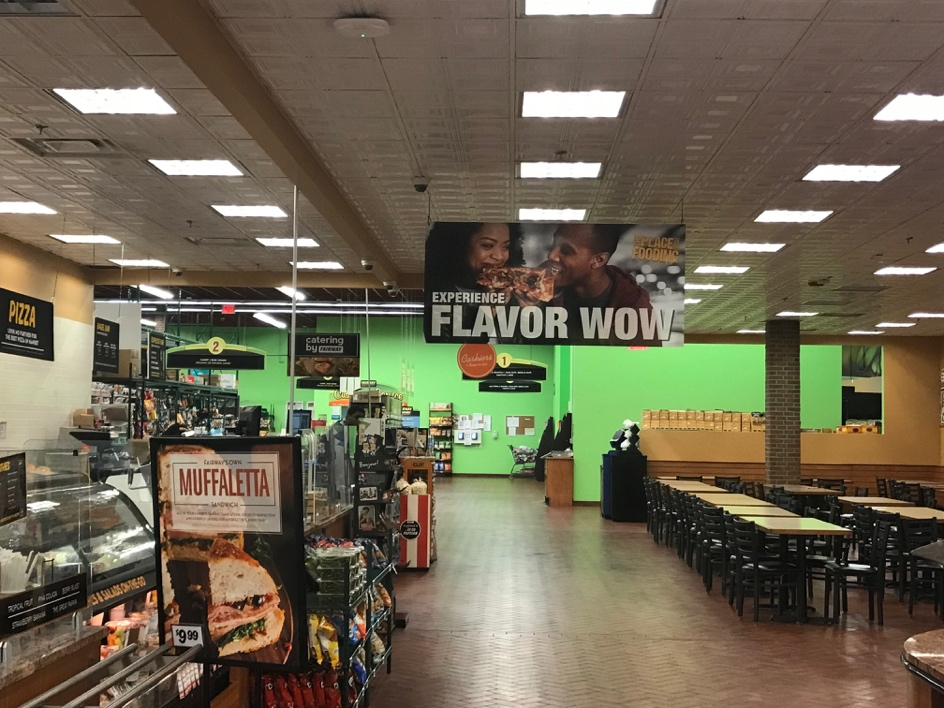For the legal notices.
This kind of story requires a timeline. Grocery store chain Fairway Markets went into Chapter 11 bankruptcy. The chain had a copyright license for the use of photographs in the stores on “Store Furnishings” granted by photographer Ferguson and Katzman Photography, Inc. (“Katzman”).


The license expired during the pendency of the bankruptcy. This is the sequence of events:
April 18, 2018: Katzman grants a two-year non-exclusive license to use 30 photographs for advertising, promotion and store decor.
Prior to the petition for bankruptcy: the debtors and a group of prepetition lenders developed a plan for a Chapter 11 bankruptcy that would result in the sale of the stores and a distribution center as going concerns.
January 22, 2020: The debtors entered into a stalking horse asset purchase agreement with a group of companies collectively referred to as “Village” in furtherance of an auction of the assets.
January 23, 2020: The debtors file voluntary petitions for relief under Chapter 11 simultaneously with a motion for entry of an order approving the auction and the process for it.
February 21, 2020: The court approves the auction. The court requires the delivery of sale notices to all persons and entities known by the debtors to have asserted any lien, claim, encumbrance, or any interest in any asset, and known creditors. The debtors also have to publish the notice once in USA Today and The New York Times.
February 27, 2020: The notices are published in USA Today and The New York Times for one day.
March 16-25, 2020: The assets are auctioned.
March 25, 2020: Village, as the successful bidder, and the debtors enter into a new asset purchase agreement.
April 14, 2020: The court has a hearing on the Sales Order for approval of the asset sale to Village.
April 19, 2020: The copyright license to the photographs ends.
April 20, 2020: The court enters the Sale Order authorizing the sale of five stores. The Sales Order had a finding that the assets were “free and clear” of any types of claims or interests, and that Village relied on that finding in entering into the asset purchase agreement. The Order also said that any holder of interests or claims who did not object were deemed to have consented and “[f]ollowing the Closing, no holder of any Interest or Claim shall interfere with Buyer’s title or quiet use and enjoyment of the Acquired Assets based on or related to any such Interest or Claim or based on any actions that the Debtor may take in these chapter 11 cases.”
May 13, 2020: The debtors and Village close the sale transaction.
August 11, 2020: An agent for Katzman sends an email to Fairway stating that Katzman had learned that Fairway was displaying the photographs in its stores after the license expired. The email was returned as undelivered and Katzman made no further effort to contact Fairway.
October 5, 2020: The court enters the confirmation order confirming the debtors’ reorganization plan. Any administrative expense claims must be filed within 35 days; failure to do so means that the claim will be “forever barred and discharged.”
October 12, 2020: The debtors publish the confirmation order notice and administrative expense claims bar date in the New York Times.
October 22, 2020: Katzman files a copyright suit in federal court (the same district as the bankruptcy court) against Fairway, Village and other store purchasers.
October 30, 2020: The effective date of the plan of reorganization.
November 6, 2020: Deadline for claims.
November 6 2020: Copyright complaint served on Fairway.
November 10, 2022: Copyright complaint served on Village.
Village filed the motion in the copyright case for a stay pending the bankruptcy court’s review of the matter. Village claimed that it was entitled to an order from the bankruptcy court enforcing the Sale Order and enjoining the copyright case because: “(1) the Store Furnishings, containing the Subject Photography, are Acquired Assets as defined under the Sale Order; (2) Village obtained the Acquired Assets free and clear of any claim by Katzman; and (3) Katzman had constructive notice of the Sale Order and is deemed to have consented to it by failing to timely oppose it.”
The Sales Order had an injunctive provision that “bars any claimholder from bringing any claims against Village ‘in any way relating to … the Acquired Assets or the Debtors’ businesses prior to the Closing Date.’” Village contended it purchased the Store Furnishings; Katzman claimed that the photographs, since they were only licensed, were not “Acquired Assets” that could have been sold in bankruptcy. The court held that the fixtures were indeed Acquired Assets, agreeing with Katzman that the Fairway license agreement was not an Acquired Asset, but nevertheless that “[i]nstead, Katzman granted the Debtors a non-exclusive license to the Subject Photography that expired as of April 19, 2020—before the parties executed the Village APA.”
I’m not sure what non-exclusive license that could be, other than the one embodied in the formal written license that the court agrees wasn’t acquired. Nevertheless, the court may have stumbled into the correct result but under the wrong theory. No one disputed that the store fixtures were lawfully made pursuant to the license. The display of the photos in the store must have also been permitted by the original license. Even though the stores were not successors to the formal license and wouldn’t have a license defense, they still wouldn’t be liable unless an act of infringement occurred. What act of infringement was Village committing? Well, nothing—no new copies were being made and, as explained by the bankruptcy court in its discussion under post-closing infringement, Katzman’s theory that the continued use was an infringement of the right of display didn’t hold water. Katzman claimed that each time a customer viewed the Store Furnishings Village has violated Katzman’s display rights. This was an incorrect construction of the right of display, though. According to the Copyright Act,
To perform or display a work ‘publicly’ means—
(1) to perform or display it at a place open to the public or at any place where a substantial number of persons outside of a normal circle of a family and its social acquaintances is gathered …
The act of display happened when it appeared at a place open to the public, not every time someone looked at it. Katzman relied on some inapposite case law involving websites for its argument that every view was in infringement, which the court rejected. So while the formal license may have contained a provision that the stores had to stop displaying the works when the license terminated, if the display would not have been a copyright infringement, then the duty to cease use was only enforceable through contract, not copyright. And Katzman had no contract to enforce against the Village and the stores. So the court’s theory of some undefined, different license was fairly inexplicable, but it nevertheless reached the correct outcome that there was no infringement—not by virtue of a license, but because no exercise of the copyright author’s exclusive rights was occurring.
Whether or not a license was necessary, Village also contended that section 363(f), as applied through the Sale Order, stripped Katzman and other claimholders of the right to assert claims “In any way relating to … the Acquired Assets or the Debtor’s businesses prior to the Closing date.” The wording the Sales Order was broad enough to strip Katzman of any rights it might have had pre-closing because Katzman
provided multiple layers of implicit consent to the Debtors’ sale process and resulting outcomes, including the Sales Notice, Confirmation Order, Sales Order and the Injunction Motion. At multiple junctions, Katzman could have, but failed to, object to receiving publication notice of relevant deadlines, object to the Debtors’ sale, or otherwise attempt to enforce its copyright claims before the Court approved the ‘free and clear’ sale of the Acquired Assets.
Well, maybe. The Sales Notice and Confirmation Order were during the licensed use, so I don’t think those should count against Katzman. As to the later notices, Katzman claimed that, because of its correspondence with Fairway about the termination, it was a known creditor and therefore should have received actual notice, but the court didn’t think so. The complaint wasn’t served until November and Katzman’s email bounced back, meaning that Fairway never received it. Katzman was therefore an unknown creditor and only entitled to publication notice, not actual notice.
Finally, Katzman claimed that Village’s continued use the photo post-closing was an infringement, but this is where the court analyzed the right of display, holding that there was no copyright infrignement of the right of display (for the reasons explained above) by the stores’ continued use of the photographs.
In re Old Market Group Holdings Corp., Case No. 20-10161 (JLG) (Bankr. S.D.N.Y. Sept. 21, 2022)
This work is licensed under a Creative Commons Attribution-NoDerivatives 4.0 International License.

Leave a Reply